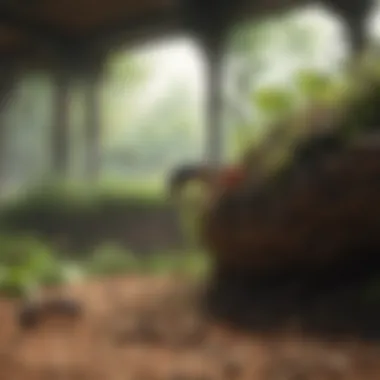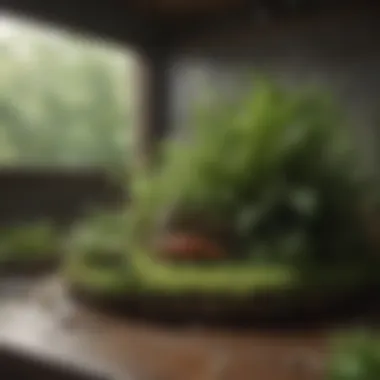Effective Strategies for Ant Colony Eradication


Intro
The presence of ant colonies can affect households and gardens profoundly, which leads to the necessity of understanding effective strategies to eradicate them. Ants, while integral to various ecosystems, may become problematic when they invade living spaces or threaten crops. This article aims to explore different methods to remove ant colonies and consider the implications of such eradication. The focus will be on the biology of ant species, triggers for colony disturbances, and methods that vary from chemical solutions to environmental changes.
Key Insights and Trends
Understanding Ant Biology
To effectively address ant infestations, it is crucial to comprehend the biology of ant species. Ants live in structured societies. Each colony has a queen, workers, and drones. The interactions between these roles affect their behavior and the success of eradication methods.
- Ants communicate through pheromones. This helps them locate food and alert others to danger.
- Different species have varied nesting habits. For instance, carpenter ants make nests in wood, whereas fire ants build mounds in open areas.
Trends in Ant Control Strategies
Recent trends in ant control reflect a growing concern for environmental health and sustainability. Home and garden owners are increasingly opting for integrated pest management (IPM) practices.
This method encourages:
- Biological controls, such as introducing predator species.
- Cultural practices, such as maintaining cleanliness to eliminate food sources.
- Mechanical barriers to prevent ants from entering homes.
By understanding the behaviors and habitats of ants, homeowner can adopt more effective methods for managing these pests.
Practical Tips and How-To Guides
Step-by-Step Eradication Process
- Identify the Species: Understanding which ant species is present helps tailor the approach for eradication.
- Locate the Nest: This can involve observing ant trails back to their source.
- Choose the Right Method: Depending on the identification and location, select an appropriate method. For instance, baiting may work well for sugar ants, while sprays may be better for others.
- Apply Treatment: Follow the product's instructions carefully. Use chemical treatments judiciously, keeping safety in mind.
- Monitor Progress: After application, assess whether ant activity diminishes.
Environmental Modifications
In addition to chemical treatments, consider these modifications to deter ants:
- Seal Entry Points: Check for gaps and cracks around windows and doors. Sealing these can block ant entries.
- Manage Cleanliness: Regularly clean areas where food particles can accumulate. Store food in airtight containers.
- Landscape Wisely: Keep plants trimmed and away from foundations to reduce pathways for ants.
"Effective ant management requires vigilance and an understanding of both the species involved and the environment they inhabit."
By implementing these practical strategies, homeowners can minimize ant problems while also being considerate of local ecosystems.
The End
Eradicating ant colonies requires thoughtful planning and implementation. Understanding the complexity of ant behavior and their role in ecosystems is crucial in selecting the right approach. The implications of removing an ant colony can resonate through the local environment, making informed decision-making vital.
By following effective strategies and modifying environmental factors, homeowners can find a balance between pest control and ecological responsibility.
Preamble to Ant Colonies
Ants are among the most diverse and successful organisms on the planet. Understanding ant colonies is crucial for those wishing to maintain a harmonious living and gardening environment. The complexities of these colonies can greatly influence control strategies. Within a single colony, various roles exist. Each member contributes to the colony's sustainability. This section offers insight into the fundamental aspects of ant colonies, setting the stage for the discussion on control methods.
What Constitutes an Ant Colony?
An ant colony is more than a collection of individual ants. It represents a structured society with clear roles. At its core, an ant colony typically consists of a queen, workers, and reproductives. The queen's primary role is reproduction. Workers handle foraging, nest maintenance, and defense. Reproductive ants, which include males and new queens, facilitate the expansion of the colony, ensuring its continuation.
A well-functioning colony can include thousands of individuals, all of which communicate and work together. This cooperation enhances their survival. Traits like pheromone trails guide workers to food sources and aid in nest defense. The social architecture of ant colonies is a testament to their evolutionary success.
Role of Ants in Ecosystems
Ants play vital roles in ecosystems. They facilitate processes central to maintaining ecological balance. For instance, ants aerate the soil, enhancing its nutrient availability. They also contribute to decomposition, breaking down organic matter. This behavior enriches the soil and promotes plant growth.
Moreover, ants maintain population control of other insects. By preying on pest species, they can help manage these populations. Their activities not only benefit their colonies but also provide broader environmental advantages.
"Ants are vital players in the ecological network, influencing both the physical environment and biological interactions."
In summary, recognizing these ecological roles underscores the complexity of ant colonies. Their removal can disrupt local ecosystems, affecting plant and animal species dependent on their activities.
Species Identification
In the pursuit of effectively managing ant colonies, species identification plays a crucial role. Understanding which species are present in a given environment allows for tailored strategies that consider the specific behaviors, habitats, and vulnerabilities of those ants. Each species of ant comes with its own set of characteristics, which can influence the choice of eradication method and its likelihood of success. Misidentification might lead to ineffective control measures that do not address the root of the problem or, worse, exacerbate it.
Common Household Ants
Common household ants include species such as the Carpenter Ant, Argentine Ant, and the Odorous House Ant.
- Carpenter Ant: Known for nesting in wood, these ants can cause structural damage in homes. They are relatively large and predominantly black or bicolored.
- Argentine Ant: Small, usually light brown, these ants form supercolonies and can quickly become widespread. They may invade food sources, particularly sugary ones.
- Odorous House Ant: Characterized by its distinctive smell when crushed, this species is black or brown and often nests in soil or beneath stones, making it easy to overlook.
Identifying the specific ant species is vital, as treatments may vary. For example, Carpenter Ants require structural repairs and targeted chemical treatments indoors, while Argentine Ants may need bait strategies for effective elimination. Understanding these distinctions assists homeowners in choosing appropriate pest management strategies that are both effective and environmentally considerate.
Ecological Impact of Different Species
The ecological impact of various ant species is significant and can vary dramatically. Some ants contribute positively to the environment, while others can disrupt local ecosystems.
- Beneficial Roles: Certain species act as natural pest control agents, as they prey on other insects. This can help maintain the balance within the local ecosystem.
- Disruptive Effects: On the other hand, invasive species like the Red Imported Fire Ant can outcompete native species, leading to a decline in biodiversity. Their predatory nature may affect the populations of beneficial insects, disturbing the local ecological balance.
Furthermore, the removal of specific ant species can have cascading effects. For example, the absence of certain ants can lead to an overpopulation of pests that were previously kept in check. This interconnectedness emphasizes the need for careful consideration when deciding on eradication methods. Balancing control measures with ecological integrity prevents unintended consequences and fosters a sustainable approach.
"The right identification leads to the right intervention. Missteps in this foundational step can have long-lasting repercussions."
By understanding the ecological implications of each species, homeowners and pest control professionals can make informed decisions that minimize negative impacts while achieving their pest management goals.
Reasons for Colony Control
Controlling ant colonies is a significant area of concern for many homeowners and property managers. The reasons for colony control extend beyond mere annoyance; they encompass health risks and economic impact. Managing ant populations effectively can prevent a range of issues that may arise if infestations are left unchecked. Understanding these reasons is essential in framing pest control strategies that are both effective and responsible.


Health Hazards Associated with Ants
Ants can pose various health risks, particularly when they invade homes or food preparation areas. Certain species, such as the Argentine ant or the odorous house ant, can contaminate food and surfaces as they forage for sustenance. They often carry pathogens from their environment, which can lead to foodborne illnesses in humans. Additionally, some people may develop allergic reactions to ant bites, which can vary in severity.
In locations like kitchens and dining areas, ant infestations can create a breeding ground for harmful bacteria. This contamination can lead to potential threats to public health, especially for children or immunocompromised individuals.
"Considering the health hazards ants present, proactive measures must be taken to mitigate their impact on human well-being."
Economic Consequences of Infestations
The economic implications of an ant infestation can be considerable. Property damage is one facet, as ants can weaken structures and compromise integrity. Carpenter ants, for example, excavate wood to create nests, resulting in significant damage. Repairing such damage can be expensive and time-consuming.
Moreover, infestations can lead to loss of revenue in businesses. Restaurants and food service establishments are particularly vulnerable since health inspections may lead to penalties or closures if infestations are discovered. This financial loss can extend to residential areas if pests affect property values or rental agreements.
In summary, understanding both health hazards and economic consequences emphasizes the need for effective ant control strategies. Homeowners, gardeners, and property managers must grasp the complexities of ant behavior to inform their pest management decisions.
Understanding Ant Behavior
Understanding ant behavior is crucial in the broader context of pest control. Ants are social insects, and their activities heavily influence their survival and the dynamics of their colonies. Gaining insights into their routine behaviors, such as foraging and nesting, allows homeowners and pest management professionals to devise effective strategies for managing ant populations.
Foraging and Nesting Patterns
Foraging is fundamental to ant survival. Ants have established paths they follow while searching for food, utilizing pheromones to communicate the presence of resources to other colony members. These pheromone trails can lead to entire colonies being attracted to human food sources, thus creating problems in homes. To eradicate an ant colony, understanding these patterns is essential.
In addition to food sources, nesting patterns provide a framework for effective control measures. Ant nests can be found in various environments: inside walls, under floorboards, or in the garden. Once a nest is located, targeted treatments can be applied to disrupt the colony's activities.
Homeowners should observe ant trails, as they often reveal entrance and exit points. Additionally, they might consider maintaining food storage in airtight containers to minimize attraction. A practical response involves combining immediate control measures, like baiting, with long-term strategies, such as environment modification. By disrupting the foraging patterns, one can effectively reduce the ant population over time.
Communication and Social Structures
Ants communicate through a range of methods, including pheromones, tactile signals, and sound. This intricate communication system allows for effective collaboration among colony members, which plays a significant role in their survival strategy. Understanding ant communication can help inform eradication efforts; for instance, disturbing pheromone trails can disorient workers and disrupt foraging activities.
The social structure within an ant colony is complex. Roles are divided among types, such as workers, soldiers, and queens. Each type has specific functions ranging from foraging, caring for the queen, or protecting the nest. Knowledge of these roles aids in implementing targeted approaches when controlling colonies. For example, if the queen is eliminated, the colony's ability to reproduce is severely hampered.
Ant behavior reinforces the necessity of a strategic approach to reduce infestations without resorting solely to chemical methods. Incorporating behavior understanding into pest management offers a more holistic solution. It encourages sustainable strategies that are less harmful to the surrounding ecosystem while effectively targeting problem areas.
"Understanding the complex behaviors of ants not only aids in their control but also enhances our overall approach to maintaining environmental balance."
Through these focused insights on foraging and communication, effective measures can be designed to create lasting solutions to ant infestations.
Chemical Methods for Eradicating Ants
Chemical methods for eliminating ant colonies represent a significant approach in the arsenal of pest control. These methods are often chosen for their speed and efficiency. When managed properly, they provide effective solutions to a pervasive problem. Understanding these techniques can help maintain a balance between effective pest control and ecological consequences.
Pesticides and Their Efficacy
Pesticides are often the go-to when dealing with ant infestations. They function primarily by disrupting the biological processes of ants, depending on the active ingredients. For example, products containing fipronil attack the nervous system of ants, leading to their quick demise. Other formulations target the digestive system, effectively terminating the feeding behavior of these pests. Their effectiveness relies on factors such as the type of ants, the formulation of the pesticide, and the application method.
However, it's essential to highlight that not all pesticides are equally effective against every ant species.
- Types of Ants: Some species build resistance to specific chemicals over time, making initial treatments ineffective.
- Application Method: Spot treatments and bait stations usually yield better results than broad spraying, as they reduce exposure to non-target species.
- Environmental Conditions: Weather and environmental factors can impact the pesticide’s efficacy. For example, rain or high humidity can wash away treatments before they take effect.
Overall, while pesticides can provide a quick knockdown of ant populations, their long-term effectiveness hinges on the careful selection of the product and proper application techniques.
Safety Considerations for Chemical Use
Safety is paramount when using chemical methods to combat ant colonies. While pesticides can effectively manage infestations, improper use can lead to health risks for both humans and pets. Here are several considerations:
- Reading Labels: The first step is to read product labels. They provide crucial information about application methods, safety precautions, and re-entry intervals.
- Personal Protective Equipment (PPE): Wearing appropriate PPE, such as gloves and masks, minimizes exposure during application.
- Ventilated Areas: Applying chemicals in well-ventilated spaces reduces inhalation risks. Close off areas being treated to limit exposure to household occupants and pets.
- Storage Considerations: Pesticides should be stored safely out of reach of children and pets, in original containers to prevent accidental exposure.
Moreover, consider the timing of applications. Avoiding peak activity periods for beneficial insects, such as bees, can lessen ecological impacts.
Always prioritize safety and environmental considerations when employing chemical methods to eradicate ant colonies.
In summary, while chemical methods can be effective for eradicating ant colonies, careful consideration is necessary to ensure that these methods are used safely and responsibly. Understanding the intricacies of pesticide efficacy and safety precautions will lead to more effective pest management while minimizing adverse effects on the surrounding environment.
Natural and Organic Elimination Methods
Natural and organic elimination methods serve as pivotal alternatives for homeowners looking to control ant populations without compromising environmental integrity. These approaches typically prioritize the use of eco-friendly ingredients and techniques that reflect a deeper understanding of pest management. Homeowners often prefer natural methods due to their safety for children and pets, while aligning with a growing movement toward sustainable living.
Various methods can be implemented, emphasizing essential oils, natural repellents, and items like boric acid that have minimal adverse effects on surrounding ecosystems. A key benefit of these organic methods is that they often encourage ecological balance rather than disruption, fostering a healthier environment. However, it’s important to consider both their effectiveness and application techniques to achieve the desired results.
Essential Oils and Natural Repellents
Essential oils are celebrated for their antimicrobial properties and can also act as deterrents against ants. Oils like peppermint, tea tree, and eucalyptus create natural barriers that ants tend to avoid.
- Benefits of Essential Oils:
- Non-toxic to pets and children.
- Easily accessible and cost-effective.
- Pleasant scents that enhance home environments.
To utilize essential oils, one may mix a few drops with water and spray the solution around common entry points or infestations. However, these oils may require regular reapplication, as their potency diminishes over time. Homeowners should remain vigilant, keeping in mind that while these oils can deter ants, they may not entirely eradicate colonies.
Boric Acid and Its Application
Boric acid stands out as a widely recognized method of ant control in organic pest management. When used correctly, it can effectively disrupt the lifecycle of ant colonies. This compound works by targeting the digestive systems of ants.
- Application Techniques:
- Mix boric acid with sweet substances like sugar water to attract ants.
- Place baited traps in areas where ant activity is high.
It is crucial to use boric acid judiciously and with precautions. While it is less toxic compared to many commercial pesticides, it should still be handled carefully, especially in households with young children or pets.


Boric acid demonstrates effectiveness not only in immediate ant management but also in preventing reinfestation when used strategically.
In summary, natural and organic elimination methods offer valuable alternatives for those seeking a less harmful approach to pest control. The combined use of essential oils and boric acid contributes to a more sustainable and eco-friendly understanding of ant management.
Environmental Considerations
When discussing the eradication of ant colonies, environmental considerations play a pivotal role. The intricacies of natural ecosystems demand that any pest control strategy is not only effective but also considerate of the broader ecological impacts. Ants are a vital part of numerous ecosystems, contributing to soil aeration, seed dispersion, and serving as food for various predators. Therefore, careless eradication can disrupt these ecological functions.
Several elements must be considered in this regard. Firstly, understanding the interconnectedness of species is crucial. Ants interact with many organisms, and removing them can have a cascading effect. For instance, if ants that transport seeds are removed, plants may struggle to reproduce, affecting the entire plant community. Additionally, many predators rely on ants as a food source. Disruption of this food web can lead to unpredictable changes in wildlife populations.
Another aspect is the chemical runoff from eradication methods. Pesticides, if not carefully applied, can contaminate soil and water sources, affecting non-target species. Not only can these chemicals harm beneficial insects, birds, and small mammals, but they can also compromise human health if they enter water supply systems. Natural methods can mitigate these risks, although they may not always provide the same level of efficacy.
In summary, environmental considerations ensure a holistic view of pest control strategies. By recognizing the role of ants within ecosystems, possible negative ripple effects can be minimized. This way, a balance between effective ant management and ecosystem health can be sustained.
Impact on Non-target Species
The impact of ant eradication on non-target species is a significant concern. When applying pesticides or other chemical treatments, the potential risks to other organisms must be carefully evaluated. Non-target species include beneficial insects, birds, and terrestrial mammals that could be affected by chemical exposure. For example, bees and butterflies, essential pollinators, might come into contact with harmful substances during their foraging activities.
Moreover, the loss of species that might compete with or control ant populations is another issue. When pesticides are used extensively, it can lead to an imbalance in the local ecosystem. The decline of these species may allow ant populations to rebound rapidly, resulting in more infestations in the future. The increase in ant population can be viewed as a direct consequence of unintentional ecological disruption.
As part of integrated pest management practices, it is vital to monitor and adapt strategies to safeguard these non-target species. Utilizing targeted pesticides, or applying them during times when non-target organisms are less active, could minimize adverse effects.
Balancing Pest Control with Ecosystem Integrity
Achieving a balance between pest control and ecosystem integrity is essential and complex. Pest control should not only aim for immediate eradication but also sustainability in the long term. This involves considering the ecological role of ants and determining the best strategies to control their population without significant disruption.
Effective methods should strive for targeted treatments. For instance, using boric acid or natural repellents can help control ant colonies while lowering risks to other species quickly and easily. Within this framework, it's necessary to factor in local biodiversity and habitat conditions.
Moreover, engaging in habitat modifications can benefit both pest control efforts and ecosystem integrity. By altering landscapes—such as removing food sources or creating barriers against nests—infestations can be managed while minimizing ecological impact. Collaborating with ecological experts during planning phases can provide valuable insights into maintaining ecological balance.
Physical Barriers and Exclusion Techniques
The utilization of physical barriers and exclusion techniques serves as an effective strategy for managing ant colonies, particularly in residential settings. These methods center on preventing ants from accessing the home or certain areas where they might infest. Unlike chemical treatments, which can have environmental repercussions, physical techniques offer a more sustainable option for pest management.
Such barriers can include various materials and tactics that deny ants easy access to food and nesting sites. By understanding the specific entry points and creating preventive measures, homeowners can significantly reduce the likelihood of ant infestations.
Sealing Points of Entry
Sealing points of entry is a foundational practice in preventing ant invasions. Ants typically exploit tiny cracks, crevices, and gaps around windows, doors, and even plumbing. Here are some key actions to consider:
- Inspection: Begin by carefully inspecting the home for potential openings. Pay close attention to areas where utilities enter the house, as these often provide accessible pathways.
- Caulking: Apply a high-quality silicone or latex caulk to seal gaps and cracks. This is particularly effective around window frames and door thresholds, where ants are likely to enter.
- Weather Stripping: Using weather stripping on doors and windows not only improves energy efficiency but also serves as a barrier against insects.
- Screens: Ensure that all windows and vents have intact screens. Repair or replace damaged screens to eliminate yet another entry point.
By implementing these actions, homeowners can create an inhospitable environment for ants, effectively reducing the chances of an infestation.
Creating Ant-proof Zones
In addition to sealing entry points, creating ant-proof zones helps in mitigating the risks of infestations. Here are some strategies for establishing these zones:
- Food Storage: Store food in airtight containers. This ensures that food odors do not attract ants, thereby deterring them from entering the premises.
- Outdoor Management: Maintain a clear buffer zone around the foundation of the home. This may involve removing debris, potential nesting sites, and overgrown vegetation that could harbor ants.
- Mulching: If using mulch in gardens, choose materials that are less appealing to ants, such as rubber mulch instead of organic options. Organic materials can provide favorable conditions for nesting.
- Regular Cleaning: Regularly clean areas where food is prepared and consumed. Crumbs and spills can attract ants, making it essential to maintain cleanliness.
"Prevention is better than cure. Investing time in physical exclusion techniques saves money and effort in the long run."
Monitoring and Maintenance
Effective monitoring and maintenance are critical components in the strategic eradication of ant colonies. After initial eradication efforts, it is essential to ensure that the infestation does not reoccur. This requires a systematic approach to regularly inspect potential problem areas and to put preventive measures in place.
Regular monitoring can help identify early signs of a reinfestation, allowing for quick action. Ants often work in colonies and their reintroduction can happen unnoticed. If not monitored, a small infestation can quickly escalate into a larger problem.
Regular Inspections for Reinfestation
Consistent inspections should be part of any pest management strategy. Homeowners are encouraged to check common entry points like cracks in walls, foundation gaps, and around windows and doors. Observing the presence of ants at certain times can provide insight into their activity patterns. A practical suggestion is to set aside a specific time each month for these inspections.
Some key indicators to look for include:
- Ant trails: Follow the pheromone trails ants leave behind, which can lead to their nest.
- Nesting sites: Examine locations such as soil, wood, or wall spaces where ants might nest.
- Food sources: Clear food debris and store food in airtight containers to reduce attractants.
"Regular inspections and prompt actions are more effective than waiting for a visible problem to escalate."
Implementing Preventative Measures
Once inspections are completed, implementing preventive measures is crucial to maintaining a pest-free environment. Prevention is often more effective and less costly than dealing with infestations after they occur.
Consider the following steps to keep ants at bay:
- Sealing entry points: Use caulk to seal any gaps in walls, flooring, or cabinetry where ants might find a way in.
- Landscaping adjustments: Ensure that vegetation is kept away from building foundations; ants often live in gardens.
- Regular clean-ups: Maintain cleanliness in both indoor and outdoor areas. Ensure that food spills are cleaned, garbage is disposed of properly, and compost heaps are well-managed.
Each of these methods contributes to a comprehensive strategy designed to reduce the likelihood of future ant problems. By staying vigilant through regular inspections and proactive preventive efforts, homeowners can effectively protect their living space from the resurgence of ant colonies.
Sustainable Pest Management Solutions
Sustainable pest management solutions are crucial in the context of climate change and environmental awareness. As we strive for effective ant control, it's significant to understand the relationship between various methods and their long-term effects on ecosystems. Sustainable approaches offer a compromise between eliminating pests and preserving biodiversity. These strategies focus on using environmentally friendly methods combined with ongoing management practices that support ecological health.
Implementing these solutions helps minimize the negative impact on non-target species, which is often a concern in traditional pest control methods. Some benefits of sustainable pest management include:
- Reduced Chemical Use: Reliance on natural substances or less toxic alternatives helps in safeguarding the environment.
- Biodiversity Protection: Target-specific strategies preserve beneficial insects and other wildlife.
- Informed Decisions: Educating homeowners about pest behavior promotes proactive measures rather than reactive solutions.
Recognizing these benefits can lead to informed practices that reinforce a commitment to nature.
Integrated Pest Management (IPM) Concepts
Integrated Pest Management (IPM) is a core strategy within sustainable pest management solutions. IPM combines different tactics to manage pest populations effectively while minimizing risks to people, property, and the environment. This holistic approach involves the following key elements:


- Monitoring: Regular assessments of pest activity allow for timely interventions.
- Prevention: Implementing cultural practices, such as altering habitat conditions, prevents infestations.
- Control Methods: Utilizing mechanical, chemical, and biological controls in rotations decreases reliance on any single strategy.
By adopting IPM practices, homeowners can solve ant issues with less environmental disruption. An IPM approach promotes long-term success and reduces costs associated with frequent pest issues.
Long-term Solutions for Ecological Balance
A fundamental aspect of sustainable pest management is the commitment to long-term ecological balance. This goes beyond simply eliminating ant colonies to encompass the health of the entire ecosystem. Long-term solutions involve several dimensions:
- Habitat Management: Creating a suitable environment for beneficial species naturally suppresses pest populations.
- Community Involvement: Engaging local communities in awareness and education foster collective measures in pest management.
- Research and Development: Investing in innovative techniques and biological alternatives can lead to new solutions that are both effective and sustainable.
The goal is to establish an environment where pests do not become problematic in the first place, allowing for coexistence.
"Sustainable solutions require a collective mindset built on long-term strategies that favor harmony with nature over immediate gain."
Case Studies on Ant Control
Understanding how different strategies to manage ant populations have succeeded or failed is crucial. Case studies provide valuable insights that extend beyond theoretical approaches. These examples offer empirical data and anecdotes that can guide future pest control methods. In a world striving for sustainable pest management, examining these real-life scenarios lays the groundwork for informed decisions and effective strategies.
Successful Eradications
Several case studies highlight successful eradications of ant colonies, exemplifying effective strategies that others can replicate. One notable instance occurred in a suburban neighborhood in California where a severe Argentine ant infestation threatened local biodiversity. Residents collaborated with local pest control experts who implemented an integrated pest management plan.
The following steps were central to their success:
- Assessment of the Problem: Initial surveys identified not only the extent of the infestation but also the possible reasons for their proliferation, such as food sources available in homes and gardens.
- Targeted Chemical Treatments: Experts employed bait stations filled with slow-acting insecticides. This method allowed worker ants to return to the nest carrying the poison, which then spread to the queen and other members of the colony.
- Long-Term Monitoring: After eradication, the community initiated regular inspections to monitor for any signs of reinfestation, ensuring any future issues could be addressed promptly.
Residents reported a significant reduction in ant sightings within months, showcasing how a well-planned and executed approach leads to successful outcomes.
Lessons Learned from Failures
While there are successful stories, it is equally important to learn from failures in ant control. One case involved attempts to eradicate the red imported fire ant in several southern states. Initially perceived as a straightforward issue, the eradication process faced numerous challenges that carried important lessons.
Key mistakes included:
- Lack of Public Education: Many homeowners misapplied chemical treatments due to insufficient guidelines. Their actions often led to localized failures and created pockets of resistance within ant populations.
- Ignoring Ecological Impact: In some cases, the methods used harmed beneficial insects and disrupted local ecosystems. This negative consequence resulted in a backlash against pest control professionals and increased skepticism among the public.
- Failure to Adapt Strategies: Rigid adherence to a single method without considering evolving ant behaviors contributed to ongoing infestations and repeated failures.
These experiences underline the complexities involved in ant control. It is vital to approach each infestation uniquely, continuously assessing both the efficacy of methods and their broader ecological impact.
"Success is not final, failure is not fatal: It is the courage to continue that counts."
— Winston S. Churchill
Ethical Implications of Ant Eradication
Understanding the ethical implications of ant eradication extends beyond mere pest control. It requires a thoughtful consideration of biodiversity, ecosystem stability, and potential unintended consequences. Eradicating an entire ant colony may seem like a practical solution for a localized problem, but the effects ripple through their surrounding environment. Homeowners, gardening enthusiasts, and anyone affected by pest activity hold a responsibility to comprehend these effects before proceeding with eradication methods.
Biodiversity Consequences
The impact of eradicating ant colonies on biodiversity is profound. Ants play vital roles in ecosystem functions, such as soil aeration, seed dispersal, and pest control. When their populations are significantly reduced or removed, the implications may include:
- Disruption of Food Chains: Ants serve as a food source for various predators, including birds and mammals. Removing them can affect these species' populations.
- Altered Soil Health: Ants contribute to the decomposition process, thus aiding in nutrient cycling. A decline in ant populations may lead to poorer soil conditions.
- Pest Population Explosions: Ants often keep certain pest populations in check. Without them, other pests may proliferate, potentially leading to further problems.
In light of these consequences, any strategy for ant eradication must be implemented with a comprehensive understanding of local ecosystems and the specific ant species involved. The balance between human needs and ecological stability calls for informed decisions on pest control methods.
Moral Considerations in Pest Control
The moral aspects of controlling ant populations also demand attention. Pests like ants often evoke mixed reactions; while they may pose challenges in domestic settings, they also provide numerous ecological benefits. Homeowners and pest control professionals must navigate these feelings when considering eradication. Some key moral considerations include:
- Consideration of Suffering: Chemical methods may cause unnecessary distress and pain to ants. This raises questions about the ethical approach to pest control, encouraging a shift towards more humane methods.
- Ecosystem Integrity: The effects on the larger ecosystem should be a primary focus. Decisions should weigh the benefits of eradicating a nuisance against the potential harm to biodiversity and ecosystem function.
- Responsibility to Non-target Species: The potential harm to non-target organisms should be scrutinized. Eradication efforts should minimize collateral damage wherever possible.
"The goal in pest control should not simply be to eliminate a species, but to manage them in a manner that is respectful of their ecological roles."
Ultimately, ethical considerations in ant eradication necessitate a balanced approach, focusing not merely on immediate convenience but on long-term implications for both human interests and ecological health.
Future Directions in Ant Control Research
Ant control is an evolving field, with continuous advancements in both technology and methodology. Understanding future directions in ant control research is crucial for effective pest management. The focus is not only on eradicating colonies but also on developing strategies that align with ecological sustainability.
Advancements in Pest Control Technologies
Innovations in pest control technologies pave the way for more effective and targeted approaches to ant management. Recent developments include the use of smart traps that can identify and monitor ant movements, allowing for a timely response to potential infestations. These traps utilize sensors and data analytics, providing real-time feedback about ant activity. This can help homeowners or pest control professionals make informed decisions regarding intervention strategies.
Moreover, the trend is shifting towards the development of less harmful and more sustainable chemical formulations. New-generation baits that attract ants while minimizing toxicity to non-target species create safer environments for humans and pets. It is also worth noting the significance of integrating technology with traditional methods. Combining chemical treatments with anti-pest thermal technologies provides a dual approach that enhances overall effectiveness.
The Role of Genomics and Genetic Modification
Genomics and genetic modification present groundbreaking opportunities in ant control. Researchers are increasingly exploring how genetic techniques can be applied to manage ant populations. For instance, targeted gene editing can create sterile males, disrupting mating cycles and leading to population decline. This innovative method showcases a potential pathway to control invasive species without the widespread application of pesticides.
Furthermore, understanding the genomics of ants can lead to insights into their behaviors, adaptations, and vulnerabilities. By mapping the genomes of various ant species, scientists can identify specific genes tied to their survival abilities in different environments. Such knowledge not only informs control strategies but also contributes to broader ecological studies.
Culmination
Understanding the various strategies for eradicating ant colonies is crucial for homeowners and environmental stewards alike. This article has delved into the complexities of ant behavior, the methods available for control, and the broader ecological implications that accompany these actions. It is not merely about removing a nuisance but ensuring that any approach taken is informed and responsible.
Summarizing Key Insights
In summary, effective ant management requires a blend of various strategies. Homeowners must consider not only the immediate impact on their living space but also the ecological consequences of their chosen method. We have highlighted different types of ant species, their roles within the ecosystem, and the associated risks they pose. Key insights include:
- Ants contribute significantly to soil health and aeration.
- Chemical methods can be effective but must be used cautiously to protect non-target species.
- Natural methods, such as using essential oils, offer less harmful alternatives.
Each choice carries weight, and understanding these facets increases the likelihood of long-term success in pest control efforts.
Importance of Informed Decisions in Ant Management
Making informed decisions regarding ant management cannot be overstated. Homeowners should evaluate their specific situation—taking into account the type of ant species present, the extent of the infestation, and the potential impact on their environment. Good practices include:
- Regular monitoring to foresee potential infestations.
- Utilizing Integrated Pest Management (IPM) approaches that value both efficacy and safety.
- Considering the ecological balance before implementing drastic actions.
Being educated about the implications can prevent unnecessary harm to the environment and support the health of ecosystems. As a community of responsible homeowners, fostering a balance between management and stewardship is essential. Proper understanding can lead to practical solutions that manage pest issues without sacrificing ecological integrity.



